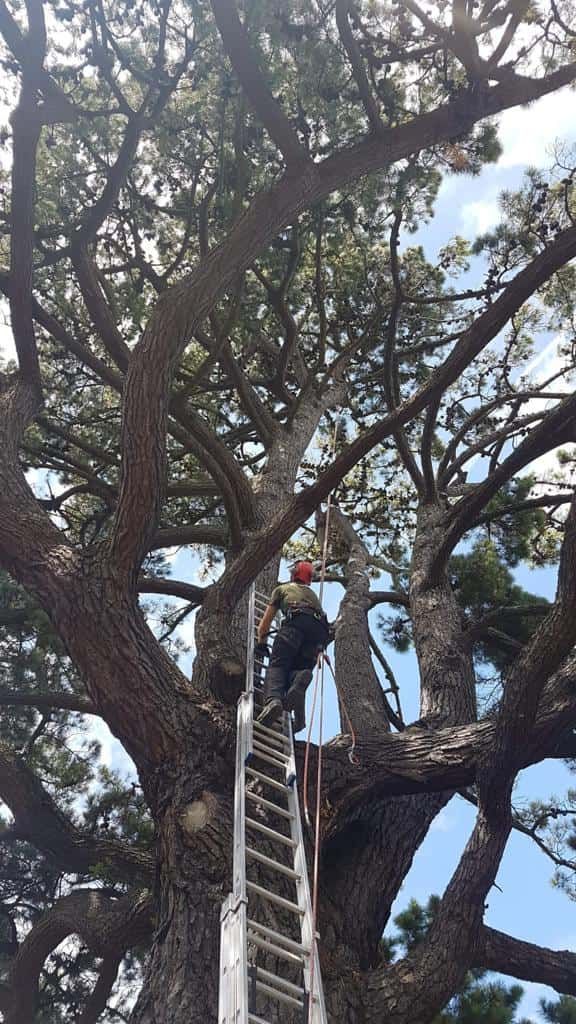Trees are magnificent features in any landscape, offering shade, beauty, and environmental benefits. However, without proper maintenance, their crowns — the upper canopy made up of branches and leaves — can become overly heavy and unbalanced. This not only affects the health and stability of the tree but can also pose a risk to nearby structures and people. LM Tree Surgery Hayling Island specialises in identifying and correcting crown imbalances, ensuring trees across Hayling Island, Hampshire remain safe, healthy, and visually appealing.
Understanding What Causes Heavy Tree Crowns
A tree’s crown is designed to grow in balance with its trunk and root system. When this balance is disrupted, the weight of the crown can become too great for the supporting structure, leading to potential safety issues and decline in tree health.
Several common factors contribute to excessive crown weight:
1. Lack of Regular Pruning
Without routine maintenance, trees naturally continue to grow outwards and upwards. Over time, new shoots, branches, and foliage add weight unevenly, especially towards the outer canopy. This makes the crown denser and heavier, increasing wind resistance and the risk of branch failure.
2. Storm and Wind Growth Patterns
In coastal areas like Hayling Island, trees are frequently exposed to strong winds. As a result, they often grow unevenly, developing thicker branches on the sheltered side. This uneven distribution can cause a lopsided crown that places pressure on the trunk and roots.
3. Internal Decay or Weak Branch Joints
When inner branches decay or grow in weak formations — known as included bark unions — they struggle to support the increasing canopy weight. The result can be sudden branch drops, especially in mature trees with large canopies.
4. Rapid Growth or Over-Fertilisation
Certain species grow quickly and develop expansive crowns in a short time. Without careful management, this rapid expansion can outpace the tree’s structural capacity, leading to drooping limbs and strain along the trunk.
Why an Overly Heavy Crown Is a Serious Problem
Ignoring a heavy or unbalanced crown can have wide-ranging consequences — both for the tree itself and its surroundings.
Structural Instability
An overloaded canopy increases the strain on branches and the trunk, making breakages far more likely during storms. In severe cases, the entire tree can become uprooted if the imbalance grows too extreme.
Reduced Airflow and Light Penetration
Dense crowns restrict sunlight from reaching inner branches, leading to dieback and weak wood growth. Poor air circulation also increases humidity within the canopy, encouraging fungal infections and pest infestations.
Increased Risk to Property and People
When branches overextend beyond the tree’s natural limits, they pose a real danger to nearby structures, vehicles, and passers-by. Large branches can fall unexpectedly, especially during high winds or after prolonged rainfall when the wood is saturated and heavy.
Declining Tree Health
A tree with an unbalanced or heavy crown diverts more energy into supporting unnecessary weight, rather than healthy growth. Over time, this can lead to premature decline and structural deterioration.
How Crown Reduction Can Help
One of the most effective solutions to managing heavy crowns is professional crown reduction. This specialist pruning technique carefully removes a portion of the outer canopy to reduce overall weight, improve balance, and maintain the tree’s natural shape.
LM Tree Surgery Hayling Island uses precision methods to ensure each cut supports both the tree’s health and appearance.
Key Benefits of Crown Reduction:
- Reduced wind resistance: The tree becomes more aerodynamic, lessening the chance of damage during storms.
- Improved structure and balance: Weight is evenly distributed to prevent stress on key branches.
- Healthier regrowth: The tree can focus its energy on maintaining strong, stable limbs rather than overextending weak ones.
- Enhanced light and airflow: Increased sunlight penetration benefits both the tree and surrounding vegetation.
Crown reduction should always be performed by experienced arborists who understand the biology of the tree and the correct cutting techniques. Poorly executed pruning can cause wounds that invite disease or stimulate rapid, weak regrowth.
Crown Thinning vs Crown Reduction — Knowing the Difference
While crown reduction reduces the size and spread of a canopy, crown thinning focuses on selectively removing smaller branches throughout the crown. This process lightens the canopy without significantly changing the tree’s overall shape.
LM Tree Surgery Hayling Island often recommends crown thinning for trees with particularly dense foliage or those that suffer from poor airflow. Both methods can be used together, depending on the species, growth pattern, and location of the tree.
Signs Your Tree’s Crown May Be Too Heavy
Homeowners in Hayling Island, Hampshire should watch for signs that indicate a canopy has become overgrown or unbalanced:
- Branches extending too close to roofs, power lines, or neighbouring properties.
- Noticeable leaning or uneven canopy spread.
- Drooping or cracking branches after rainfall.
- Deadwood or broken limbs within the canopy.
- Large branches crossing or rubbing together.
- Excessive shading over gardens or lawns.
If you notice any of these symptoms, it’s wise to schedule a professional assessment. Early intervention prevents further strain and avoids costly damage later on.
How Professional Tree Surgeons Manage Heavy Crowns
Crown work requires skill, planning, and an understanding of tree physiology. LM Tree Surgery Hayling Island uses tailored techniques based on the tree’s species, size, and surrounding environment.
The process typically includes:
- Initial inspection – Assessing the tree’s structure, balance, and health.
- Selective pruning – Removing weight from specific areas without harming the natural form.
- Maintaining proportion – Ensuring the crown remains symmetrical and stable.
- Waste removal – Clearing all debris to leave the site clean and tidy.
Every cut is made with precision to encourage healthy regrowth and maintain long-term stability.
Preventative Maintenance for Long-Term Health
After crown reduction, continued maintenance ensures the tree stays in good condition. Regular pruning every few years helps prevent the canopy from becoming dense again, while periodic inspections identify early signs of imbalance.
In Hayling Island, where strong coastal winds are common, maintaining the right crown structure is particularly important to prevent windthrow and branch failure. LM Tree Surgery Hayling Island offers ongoing maintenance plans tailored to the unique environmental conditions of Hampshire’s coastal landscape.
Conclusion
When a tree’s crown becomes too heavy, it not only threatens the tree’s stability but also poses a risk to nearby properties and people. Regular maintenance, including professional crown reduction, keeps trees strong, balanced, and healthy for years to come.
Homeowners across Hayling Island, Hampshire can rely on LM Tree Surgery Hayling Island for expert advice and specialist pruning services. By managing crown weight effectively, you protect both your trees and your property — ensuring safety, beauty, and peace of mind throughout every season.
Call us on: 023 8235 2063
Click here to find out more about LM Tree Surgery Hayling Island
Click here to complete our contact form and see how we can help with your tree needs.

